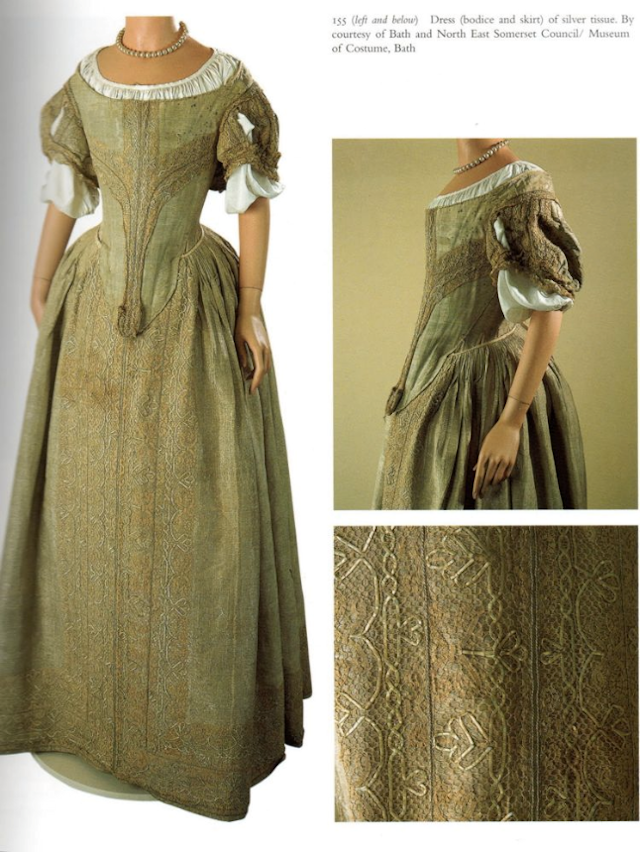Today we take a look at another rare survivor though time, the silver tissue gown from the Bath Fashion Museum. Dating from around 1660, an example of the most popular style of its time with its wide neckline, structured bodice, short sleeves and pleated skirt. Though it may appear a bit worn and drab today, it was once resplendent in all its shining silver glory. The silk fabric is woven with silver metallic threads which made the dress gleam like liquid metal when it was new so many centuries ago.
The gown is a perfect example of the 1660's silhouette. The bodice is boned and stiff to create the conical off the shoulder shape. The sleeves are short with openings for the fine linen chemise to puff through. Both the bodice and the skirt are decorated with fine lace and tiny thin strips of parchment woven like cord through the lace to create an abstract floral design. As the label from the Bath Fashion Museum states below, it is rather a small dress, possibly for a girl or young woman being presented at court.
 |
| Label from my visit to the museum in 2012 |
Though the two photos above are of less than ideal quality (these were the dark days before I had a DSLR), I wanted to include the label and show the sparkling effect the silver silk still has today. The low lighting of the museum, like the candle light of the 17th century, allows the dress to sparkle in the most beautiful way. I felt so honored to be able to see this dress in person, it felt like a pilgrimage to finally be standing before it. Anyone who studies historic dress for long knows of those select holy grail type survivors (most of which I have covered on Closet Histories before like Elizabeth I's effigy stays and Eleonora de Toledo's funeral dress). The older pieces of costume that have miraculously survived certainly hold a sort of reliquary quality today.
While searching for photos for this post I came across a particular album of photos from Cathy Hay, renowned in the online historic dress community for her sewing mastery and devotion to the study of dress. It seems Cathy was able to take a close look the the silver tissue gown off display at the museum! What a great opportunity to see what the dress looks like up close and inside, and also learn how such a dress was put together in the 17th century. Click on the photos below to be taken to Cathy's photobucket page with the rest of her fascinating photos!
The back of the bodice, giving us a glimpse of the lining. Notice how much support the museum has constructed to maintain the shape and condition of the garment. Acid free fabrics and tissue paper, and also approved types of foam, are all tools for a museum to ensure the garments are stored in a safe way.
Here is the front of the bodice. You can see areas of the fabric have brown dots like foxing on old paper, here the problem could also be oxidation of the metallic threads in the silver fabric. Silk is fragile at the best of times, but silk that is over 300 years old is even more so. You can see how the bottom edge of the bodice has bound tabs like stays. The stiff bodice is essentially providing the function of stays, being a fusion of the usual two layers, stays and bodice in one.
Here we see the waist of the skirt. There are literally hundreds of pleats in the skirt which are sandwiched in what looks like a linen tape waistband. The center front is left smooth with no pleats and the skirt closes in the back by knotting the ends of the waist ties.
The 17th century is the last where extant examples of dress are extremely rare and uncommon. Looking forward as we eventually move into the 18th century, we will have many more extant examples to study and I for one can't wait! But first, next week we take a look at the 17th puritan and the movements influence on fashion, see you then!
All of the information for this post has been gathered from the textbook Survey of Historic Costume (5th edition) by Phyllis G. Tortora and Keith Eurbank, from the links above or my own knowledge. I want to share the resources I come across with all of you as much as possible. The portraits used to illustrate today's post are credited to either the museum where they reside (whenever possible) or the source where I found them, and are linked via their fig. # underneath. Again I repeat my disclaimer that I am not a historian, and if you have corrections or additions for this post, please begin the discussion in comments as I would love to learn more!
Thanks for reading!
Thanks for reading!







It's absolutely breathtaking! I can easily close my eyes and imagine its former, vibrant glory and how its elegant hues much have shone be candlelight come evening.
ReplyDelete♥ Jessica